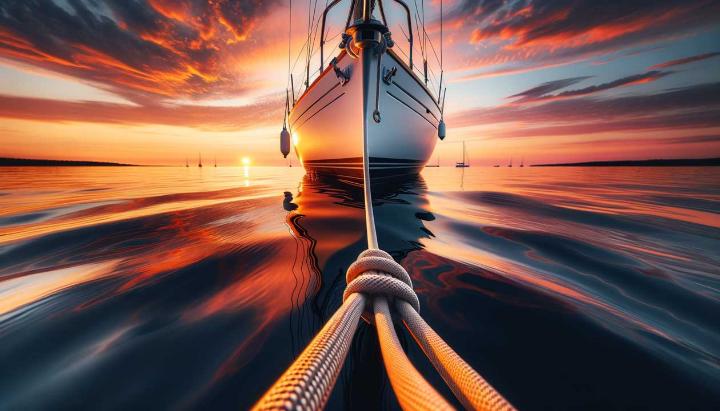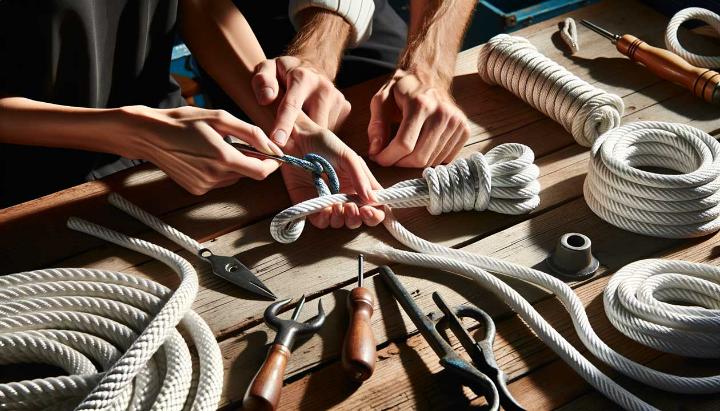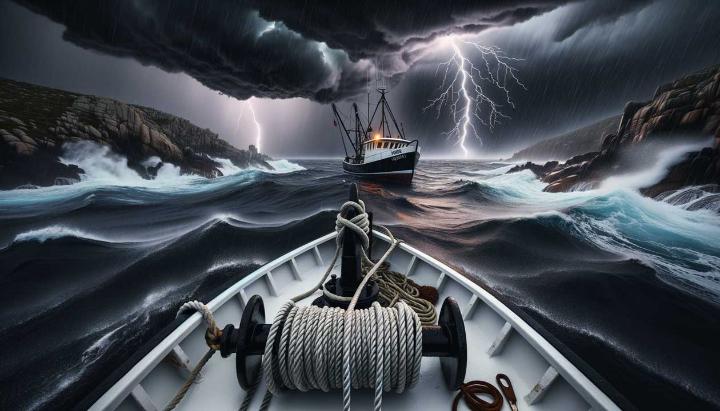Have you ever found yourself adrift in a sea of anchor rope options, wondering which one will keep your vessel safe and secure? You're not alone. In the world of boating, choosing the right anchor rope can mean the difference between a peaceful night's sleep and a nautical nightmare. Welcome to The Ultimate Guide to 1 Inch and Half Inch Anchor Ropes, where we'll navigate the choppy waters of anchor rope selection together.
At iRopes, we've spent years perfecting the art of rope manufacturing, and we're here to share our expertise. Whether you're a seasoned sailor or a weekend warrior, understanding the nuances of 1 inch anchor ropes, half inch anchor ropes, and wire rope anchors is crucial for your maritime adventures.
In this comprehensive guide, we'll explore the strengths and applications of different anchor rope sizes, dive into the benefits of customisation, and reveal why sometimes, a wire rope anchor might be your best bet. We'll cover everything from material selection (did you know we specialise in nylon and polyester ropes?) to the importance of metal thimble eye connections.
So, grab your captain's hat and prepare to set sail on a journey of discovery. By the end of this guide, you'll be equipped with the knowledge to choose the perfect anchor rope for your vessel, ensuring safety, performance, and peace of mind on the water. Are you ready to weigh anchor and dive in?
Understanding the Basics of 1 Inch Anchor Rope
When it comes to securing your vessel, choosing the right anchor rope is crucial. As a seasoned sailor, I've learned that a 1 inch anchor rope is a popular choice for many boat owners, offering a perfect balance of strength and manageability. Let's dive into the essentials of this robust marine workhorse.
Choosing the Right Anchor Rope Size
Have you ever wondered how to determine the ideal anchor rope size for your boat? Here's a handy rule of thumb: for every 9 feet of boat length, you'll want 1/8 inch of rope diameter. So, a 1 inch anchor rope is typically suitable for vessels around 72 feet in length. However, factors like your boat's weight and local weather conditions can influence this decision.

Materials and Types of Anchor Ropes
When it comes to materials, nylon and polyester are the top contenders for 1 inch anchor ropes. Each has its unique properties:
- Nylon: Offers excellent strength and stretch, absorbing shock loads and providing a smoother ride in choppy waters.
- Polyester: Known for its durability and resistance to UV damage, making it ideal for long-term use in sunny climates.
My personal favourite is the 3 Strand Polyester rope. It's easy to handle, resists chafe, and doesn't absorb water, which means it won't get heavier when wet.
Proper Anchor Rope Length and Usage
Remember, the length of your anchor rode is just as important as its diameter. A good rule of thumb is to have an anchor rode length that's 7-10 times the depth of the water you're anchoring in. This allows for proper scope, ensuring your anchor sets correctly and holds your boat securely.
Pro Tip: Always carry extra length of anchor rope. It's better to have too much than too little when you're trying to set your anchor in deeper waters.
Understanding these basics of 1 inch anchor ropes will help you make an informed decision for your vessel. Remember, the right anchor rope is an investment in your safety and peace of mind on the water. Have you considered upgrading your anchor rope recently? It might be time to reassess your current setup and ensure you're using the best option for your boating needs.
Benefits of Half-Inch Anchor Rope for Boating Safety
As an avid sailor with years of experience navigating various waters, I've come to appreciate the unique advantages of half-inch anchor ropes. These versatile lines strike a perfect balance between strength and manageability, making them an excellent choice for many boating enthusiasts. Let's dive into why a half-inch anchor rope might be the ideal solution for your vessel.
Lightweight and Easy to Handle
One of the most significant benefits of a half-inch anchor rope is its lightweight nature. Have you ever struggled with a bulky anchor line, feeling the strain in your back as you haul it aboard? I certainly have, and it's not an experience I'd recommend. Half-inch ropes offer a much more user-friendly alternative, especially for solo sailors or those with limited strength.
- Reduced fatigue: The lighter weight means less physical strain during anchoring and weighing anchor.
- Easier storage: Half-inch ropes take up less space on board, leaving more room for other essential gear.
- Quicker deployment: The reduced weight allows for faster anchoring in emergency situations.
Versatility for Various Anchoring Needs
Half-inch anchor ropes are incredibly versatile, suitable for a wide range of boats and anchoring scenarios. In my experience, they're particularly well-suited for vessels around 28 feet in length. However, the actual suitability depends on various factors, including your boat's weight and local weather conditions.

These ropes excel in both shallow and deep-water anchoring, providing enough strength for most recreational boating needs while remaining manageable. Whether you're enjoying a lazy afternoon in a calm bay or seeking shelter from an approaching storm, a half-inch anchor rope can rise to the occasion.
Cost-effectiveness Compared to Thicker Ropes
Let's face it: boating can be an expensive hobby. That's why I always appreciate gear that offers great value for money. Half-inch anchor ropes are often more budget-friendly than their thicker counterparts, without compromising on performance.
- Lower initial cost: Half-inch ropes are generally less expensive to purchase than thicker options.
- Reduced wear and tear: The lighter weight means less stress on your boat's cleats and fairleads, potentially saving on maintenance costs.
- Fuel efficiency: Every bit of weight savings contributes to better fuel economy, especially on longer trips.
Remember, while half-inch anchor ropes offer numerous benefits, it's crucial to choose the right anchor line material and length for your specific needs. In the next section, we'll explore how to select the perfect anchor rope for your boat, ensuring both safety and performance on the water.
Pro Tip: Always check your local marine guidelines and regulations when selecting an anchor rope. Some areas may have specific requirements based on boat size and water conditions.
Customization Options for Anchor Ropes
As a seasoned sailor, I've learned that the key to a safe and successful anchoring experience lies in the details. One of the most crucial aspects is having an anchor rope that's tailored to your specific needs. Let's dive into the world of anchor rope customization and explore how you can create the perfect setup for your vessel.
Choosing the Right Rope Material
When it comes to anchor ropes, material selection is paramount. I remember a time when I underestimated its importance and found myself in a precarious situation during a sudden squall. Since then, I've become a firm advocate for choosing the right material. Here are the top contenders:
- Nylon: The gold standard for most anchoring situations. Its strength and elasticity make it ideal for absorbing shock loads.
- Polyester: Excellent for its low stretch properties and UV resistance, perfect for long-term mooring in sunny climates.
- Polypropylene: While less common, it's lightweight and floats, which can be useful in certain scenarios.
In my experience, nylon is the best all-rounder for most boaters. Its ability to stretch and absorb energy can be a lifesaver in rough conditions.
Length and Diameter Considerations
Getting the length and diameter right is crucial for safe anchoring. I once saw a beautiful yacht dragging its anchor because the owner hadn't considered the depth of the anchorage. Don't make the same mistake!
For length, a good rule of thumb is to have at least 7 times the depth of water you plan to anchor in. For example, if you're anchoring in 10 metres of water, you'll want at least 70 metres of rope.
As for diameter, it depends on your boat's size and weight. Generally, for every 9 feet of boat length, you'll want 1/8 inch of rope diameter. But always err on the side of caution - it's better to have a rope that's slightly too thick than one that's too thin.
Remember: The right combination of length and diameter is crucial for your safety. Don't skimp on either!
Chain and Splice Options
Adding a length of chain to your anchor rope can significantly improve your anchoring performance. The weight of the chain helps keep the anchor rode low to the seabed, increasing holding power. In my years of sailing, I've found that a good rule of thumb is to use a chain length equal to your boat length.
When it comes to splicing, there are several options:
- Eye splice: Creates a strong, permanent loop at the end of the rope.
- Back splice: Prevents the end of the rope from fraying.
- Short splice: Joins two ropes together.
Personally, I prefer an eye splice with a thimble for connecting to the chain. It provides a secure connection and helps prevent chafing.

Remember, customizing your anchor rope isn't just about following rules - it's about understanding your specific needs and conditions. Have you considered the unique requirements of your favourite anchorages? Take some time to think about where you sail most often and what challenges you face. With the right customization, you'll be well-prepared for whatever the sea throws your way.
Advantages of Wire Rope Anchors in Specific Situations
As a seasoned mariner, I've come to appreciate the unique benefits that wire rope anchors offer in certain scenarios. While traditional chain and rope anchors have their place, wire rope anchors shine in specific situations where strength, durability, and versatility are paramount. Let's dive into why these robust anchoring solutions might be the perfect choice for your vessel.
Strength and Flexibility: Key Benefits of Wire Rope Anchors
Wire rope anchors are a marvel of engineering, combining multiple strands of wire twisted together to create a formidable anchoring solution. This unique construction offers several advantages:
- Superior strength-to-weight ratio: Wire rope anchors provide exceptional holding power without the excessive weight of traditional chain anchors.
- Remarkable flexibility: The multi-strand design allows wire rope to bend and flex, adapting to changes in water conditions and vessel movement.
- Reduced kinking and tangling: The flexible nature of wire rope helps prevent the frustrating knots and tangles often associated with traditional rope anchors.
I remember a particularly stormy night off the coast of Tasmania where my wire rope anchor held firm while other boats around me struggled with their traditional setups. The combination of strength and flexibility proved invaluable in those challenging conditions.

Enhanced Resistance to Abrasion and Corrosion
One of the standout features of wire rope anchors is their impressive durability in harsh marine environments. Here's why they excel:
- Abrasion resistance: The multi-strand construction distributes wear more evenly, reducing the impact of friction against rough seafloors.
- Corrosion resistance: Many wire rope anchors are made from galvanized or stainless steel, offering superior protection against saltwater corrosion.
- Longevity: With proper care, a wire rope anchor can outlast traditional rope anchors, providing reliable service for years.
During my years of coastal cruising, I've noticed a significant difference in the lifespan of my wire rope anchors compared to traditional options. The reduced need for replacement not only saves money but also provides peace of mind during extended voyages.
Applications of Wire Rope Anchors Across Industries
While we've focused on marine applications, it's worth noting that wire rope anchors have found their place in various industries:
- Offshore oil and gas: Used for mooring large platforms and vessels in deep-water environments.
- Construction: Employed in temporary structures and crane stabilization on challenging terrains.
- Mining: Utilized for securing heavy equipment in open-pit mines.
The versatility of wire rope anchors speaks to their effectiveness in demanding situations across multiple sectors.
Pro Tip: When considering a wire rope anchor, always consult with a marine specialist to ensure you select the right size and type for your specific vessel and intended use.
As we wrap up this section, it's clear that wire rope anchors offer significant advantages in specific situations. Their unique combination of strength, flexibility, and durability makes them an excellent choice for challenging anchoring scenarios. Have you considered upgrading to a wire rope anchor for your vessel? It might be the game-changer you need for your next maritime adventure.
For more insights into the benefits of wire ropes, explore our article on why UHMWPE ropes surpass wire rope for hoist applications.
Get Your Custom Anchor Ropes Today!
Choosing the right anchor rope is key to marine safety and performance. This guide explores the strengths of a 1 inch anchor rope, ideal for larger vessels needing durable materials like nylon and polyester, and highlights the versatility and cost-effectiveness of a half inch anchor rope for smaller boats. Additionally, discover the robustness of a wire rope anchor for long-term mooring. With iRopes, you can customise your anchor ropes with personalised lengths, colours, and metal thimble eyes for secure connections. Ensure you have the best equipment for your marine needs. Please fill in the inquiry form located above for more information or to place an order.